![]()
![]()
![]()
Use LEFT and RIGHT arrow keys to navigate between flashcards;
Use UP and DOWN arrow keys to flip the card;
H to show hint;
A reads text to speech;
14 Cards in this Set
- Front
- Back
|
How has the view of purchasing / procurement changed?
|
In the past, purchasing was viewed as a non-strategic area. Now, purchasing/procurement is seen as
-strategic decision - collaboration with suppliers - relationship-based - "Total Cost" approach |
|
|
What is the total cost approach?
|

It looks at all the costs associated with purchasing / procurement listed above, some of which may be intangible, and includes all these into the decision of how to procure
|
|
|
Explain the Krajlic's Supply Matrix image.
|
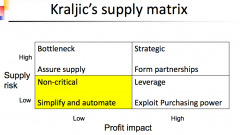
see above
|
|
|
What does Krajlic's Supply Matrix do?
|
It looks at each product from both a supply risk (FIND OUT WHAT THIS IS) and profit impact perspective. For instance, when the profit impact is high and supply risk is low, we view these as leverage items for which we would exploit our purchasing power where possible. This is different from when the supply risk is high and the profit impact is high as well: in that instance, the part is that important to the company that the company should form partnerships with suppliers.
|
|
|
What are the ways in which a company can engage in supplier collaboration? Give an example of each category?
|
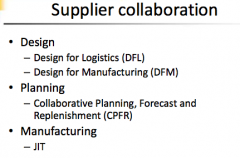
See above
|
|
|
What are the pros and cons of single sourcing?
|
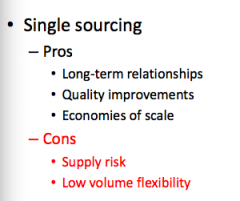
|
|
|
What are the pros and cons of multiple sourcing?
|
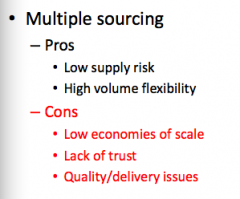
|
|
|
What is EDI?
|
Electronic Data Interchange
This includes e-commerce |
|
|
What are the different kinds of e-commerce?
|
-B2B
-B2B -C2B -C2C |
|
|
How does B2B use e-commerce?
|

E-Procurement
|
|
|
What are the e-procurement benefits to buyers? suppliers?
What are the costs? |
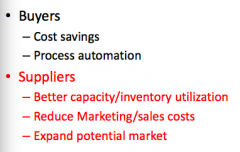
The costs can include
Transaction fee (1-5%) Licensing fee Subscription fee |
|
|
What are the types of e-marketplaces and what are the details?
|
1. Public - open to any firm (itradenetwork)
2. Private - implemented by a buyer (vwgroupsupply) 3. Consortia-based - established by a group of companies within the same industry (exostar) |
|
|
What do e-marketplaces do?
|
1. Automate procurement
– More data accuracy – Faster exchange of information – Reduced order processing cost – Organizational issues 2. Provide collaboration tools – Share information – Integrate business processes 3. Online auctions – Reverse auctions – Lower entry barrier – 20% savings on average – Faster than traditional negotiation mechanisms 4. Online catalogs – Electronic presentation of products |
|
|
What are the risks associated with e-procurement
|
• Buyers may not want to share sensitive data
• Suppliers may not accept a system owned by the buyer • Suppliers may not accepts reduced margins • E-auctions maybe not indicated for strategic, long-term relationships |

